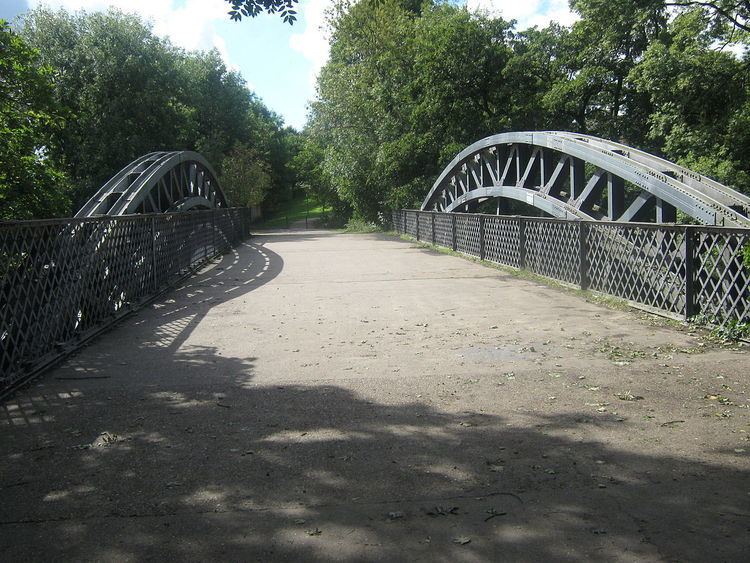Carries Foot (previously rail) Address 54, Derby DE1 3FB, UK Total length 62 m Materials Wrought iron, Cast iron | Crosses River Derwent Design Rail Bridge Construction begin August 1877 Height 25 m Width 10 m Locale Derbyshire | |
 | ||
Similar Derby Friargate railway st, Cathedral Green Footbridge, Exeter Bridge, Derby Silk Mill, St Alkmund's Church | ||
Handyside bridge in derby a film about this 134 year old bridge built by andrew handyside co ltd
Handyside Bridge, also known as Derwent Bridge, is a former railway bridge in Darley Abbey, Derbyshire, England, built by Andrew Handyside & Co. that was converted to a foot bridge in 1976.
Contents
- Handyside bridge in derby a film about this 134 year old bridge built by andrew handyside co ltd
- History
- References
It is a riveted, wrought iron, Tied-arch bridge at the entrance to Darley Park in Derby spanning the River Derwent and was part of the Great Northern Railway Derbyshire Extension popularly known as the (Derby) Friargate Line. The next station was Friargate Station with another Bridge, also built by Andrew Handyside.
History
The bridge was built by Andrew Handyside and Company in 1878 when the Great Northern Railway's Derbyshire and Staffordshire Extension reached Derby; it designed by Richard Johnson, the GNR's chief engineer for the extension. It consists of a single span of 140 feet (43 metres), 16 feet (4.9 m) high at the centre, supported by two bow-shaped wrought iron trusses. The unusual design avoided the need for a supporting pier in the river, thus keeping the Derwent clear for navigation. It carried trains from 1878 to 1968, with the last passenger train crossing on September 5, 1964 and the last goods train in May 1968 by the Stephenson Locomotive Society, when the branch was closed by the Beeching cuts. The deck, which used to carry the track, is suspended from steel segmental arches of a lattice construction, with stone abutments. The Handyside-owned Britannia Foundry works was 200 metres downstream of the bridge and was served by sidings connected to the mainline via a branch line. This spur allowed for products from the foundry to be transported by goods train. Another substantial business near by was the refrigeration business of Sir Alfred Seale Haslam. When it was first built a Cantilever pedestrian footpath was attached to the North-side of the bridge which would have allowed the workers to cross. This was removed in 1978.
During construction, a test was carried out to see if it would hold the weight of the expected rail traffic. Andrew Handyside ran six locomotives across the bridge with a combined weight of 432 tons to see if it could take the strain.
It now forms part of the Derwent Valley Mills World Heritage Site and was designated a Grade II listed building on 2 March 1976.
The next bridge downstream to cross over the River Derwent is Saint Mary's Bridge which is 448 meters away and the next bridge upstream Haslam's Lane Toll bridge which is 1,541 meters away.
